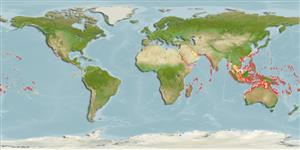>
Gobiiformes (Gobies) >
Gobiidae (Gobies) > Gobionellinae
Etymology: Gnatholepis: Greek, gnathos = jaw + Greek,lepis = scale (Ref. 45335).
More on author: Bleeker.
Environment: milieu / climate zone / depth range / distribution range
Ecologia
marinhas; estuarina associadas(os) a recifes; intervalo de profundidade 2 - 50 m (Ref. 90102), usually 2 - 20 m (Ref. 27115). Tropical; 30°N - 28°S
Indo-Pacific: widespread from South Africa to Pitcairn I.; in the Pacific north to Miyake-jima, Japan, south to Sydney Harbour, Australia; in the Indian Ocean north to Djibouti (Gulf of Tadjourah) and south to Aliwal Shoal, Kwa-Zulu Natal.
Tamanho / Peso / Idade
Maturity: Lm ? range ? - ? cm
Max length : 6.0 cm SL macho/indeterminado; (Ref. 48637)
Espinhos dorsais (total) : 7; Raios dorsais moles (total) : 11; Espinhos anais: 1; Raios anais moles: 11. Distinguished by the following characteristics: moderate-sized (up to 56 mm SL) with wide range in live colour pattern; ctenoid body scales usually reaching rear corner of opercle, occasionally ctenoid scales reaching to above rear preopercular margin; nape midline scales always cycloid, distinct flap present at end of lower lip; when alive, colour variable: body translucent white with five to seven rows of small variably coloured (dull orange, brown, red-brown to blackish) spots and/or thin lines and about six indistinct diffuse orange-brown to purple-brown blotches along midside; narrow vertical black mark on top of each eye, marks may join each other across interorbital space, and narrow black vertical line crossing cheek below eye; small dark mark of variable shape (often W-shaped) above pectoral fin base, with small yellow spot in centre; second dorsal and anal fin rays usually I,11; pectoral rays 12-18, modally 16; lateral scales 24-30, modally 27; 7-12 predorsal scales (modally 9) (Ref. 92171).
A common species that occurs in sheltered sandy areas from reef flats to seaward reefs; over sandy bottoms near pieces of rubble, rock, or coral (live or dead) (Ref. 9710, 48637, 92171). Solitary or in small groups (Ref. 90102). Feeds on algae, detritus and small benthic invertebrates (Ref. 89972).
Life cycle and mating behavior
Maturidade | Reprodução | Desova | Ovos | Fecundidade | Larvas
Larson, H.K. and D.J. Buckle, 2012. A revision of the goby genus Gnatholepis Bleeker (Teleostei, Gobiidae, Gobionellinae), with description of a new species. Zootaxa 3529:1-69. (Ref. 92171)
Categoria na Lista Vermelha da IUCN (Ref. 130435: Version 2024-2)
Ameaça para o homem
Harmless
Utilização humana
Pescarias: espécies comerciais; Aquário: Espécies comerciais
Ferramentas
Relatórios especiais
Descarregue XML
Fontes da internet
Estimates based on models
Preferred temperature (Ref.
123201): 24.7 - 28.9, mean 27.6 °C (based on 774 cells).
Phylogenetic diversity index (Ref.
82804): PD
50 = 0.5010 [Uniqueness, from 0.5 = low to 2.0 = high].
Bayesian length-weight: a=0.00977 (0.00444 - 0.02153), b=3.04 (2.85 - 3.23), in cm total length, based on LWR estimates for this (Sub)family-body shape (Ref.
93245).
Nível Trófico (Ref.
69278): 2.3 ±0.0 se; based on diet studies.
Resiliência (Ref.
120179): Elevada, tempo mínimo de duplicação da população menor que 15 meses (Preliminary K or Fecundity.).
Fishing Vulnerability (Ref.
59153): Low vulnerability (10 of 100).
Nutrients (Ref.
124155): Calcium = 173 [83, 398] mg/100g; Iron = 1.01 [0.47, 1.99] mg/100g; Protein = 18.2 [16.2, 19.9] %; Omega3 = 0.164 [0.069, 0.322] g/100g; Selenium = 23.8 [11.4, 62.9] μg/100g; VitaminA = 122 [29, 448] μg/100g; Zinc = 3.25 [2.10, 4.97] mg/100g (wet weight);
